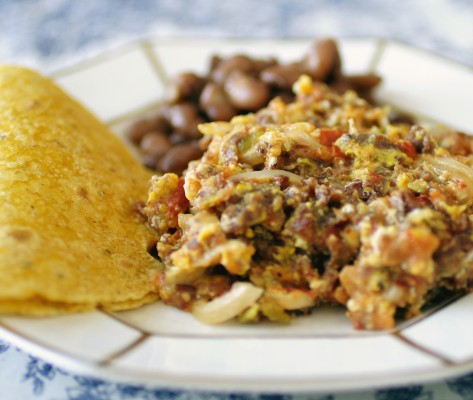Hash, Mexican Style

A lot of good cooking is derived from using up what’s at hand. In this case the recipe for Dried Beef Hash, or Aporreada de Huetamo, from The Art of Mexican Cooking by Diana Kennedy allowed me make use of some dried beef I had in the freezer (it’s always a good day when I actually remove something from our over-packed freezer instead of just adding to it) and, since this hash include eggs, some of the eggs that are being produced daily by our four hens.
I am now completely sold on hash—previously, not so much. It wasn’t something my mother or grandmothers made when I was growing up, so my only experiences with hash were the occasional times I decided to give it a try at diners—long before the more recent hash revival. I thought it was awful. (I’m sorry, but the slightly reddish color, moist and soft texture, and smell made me think of cat food.) Probably what I sampled back then was canned foodservice hash—not “house”made—and it was probably corned beef hash, the most popular in the United States, followed by roast beef hash. And the eggs would have been served on the side, not in the hash.
The recipe calls for cecina, thinly cut beef that is salted and partially dried. I don’t have access to many Mexican ingredients where I live, so I used easy-to-find dried beef, also called “chipped beef”—the type that is used to make creamed chipped beef on biscuits. The dried beef I used was smoked, which adds a wonderful dimension. From what I could gather online, it appears as though cecina may not be dried as long as American dried beef, and may be sliced into slightly larger and thicker pieces. I have no idea how closely the flavor of the version I made mimics the dish when made with Mexican dried beef, but it is delicious, regardless.
The thing that makes this hash irresistible—and what gives it its Mexican kick—is a sauce made of broiled whole tomatoes and serrano chiles and chopped garlic, all of which is blended together briefly to create a piquant binder for the cooked beef, onions, and eggs. Deep smoky and roasted flavors predominate with a pleasant tingle of flavorful chile heat. No salt is included in the recipe; the dried beef brings sufficient seasoning.
If you decide to make this recipe from The Art of Mexican Cooking, and are using run-of-the-mill American dried beef, such as what’s found in glass jars on grocery store shelves, you may want to soak the beef in water before using it to remove some of the salt. I used a better quality dried beef from a local butcher shop that is slightly less dry and less salty than the type sold in jars and stored at room temperature. (At the Wallingford Locker in Wallingford, Vermont, a truly great butcher shop, where I purchased the dried beef I used, the dried beef is kept in the cooler.) Or, best of all, go to a Mexican market to buy cecina and experience the real deal. And if you do track down cecina, please let me know how it compares to American dried beef.
